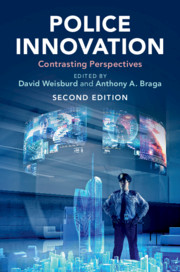Book contents
- Police Innovation
- Police Innovation
- Copyright page
- Contents
- Figures
- Tables
- Notes on Contributors
- Introduction
- Part I Community Policing
- Part II Procedural Justice Policing
- Part III Broken Windows Policing
- Part IV Problem–Oriented Policing
- Part V Pulling Levers (Focused Deterrence) Policing
- Part VI Third–Party Policing
- 11 Advocate
- 12 Critic
- Part VII Hot Spots Policing
- Part VIII Predictive Policing
- Part IX CompStat
- Part X Evidence-Based/ Risk-Focused Policing
- Part XI Technology Policing
- Index
- References
11 - Advocate
Third-Party Policing
from Part VI - Third–Party Policing
Published online by Cambridge University Press: 09 August 2019
- Police Innovation
- Police Innovation
- Copyright page
- Contents
- Figures
- Tables
- Notes on Contributors
- Introduction
- Part I Community Policing
- Part II Procedural Justice Policing
- Part III Broken Windows Policing
- Part IV Problem–Oriented Policing
- Part V Pulling Levers (Focused Deterrence) Policing
- Part VI Third–Party Policing
- 11 Advocate
- 12 Critic
- Part VII Hot Spots Policing
- Part VIII Predictive Policing
- Part IX CompStat
- Part X Evidence-Based/ Risk-Focused Policing
- Part XI Technology Policing
- Index
- References
Summary
In Third-Party Policing (hereafter TPP), police partner with others to proactively reduce crime and disorder, often focusing on places with recurrent crime problems, or people at high risk of offending. Partnerships in policing are not new. Police have always sought out and formed partnerships with a range of different entities to tackle a myriad of different types of problems. What is new for police is the expectation, and sometimes the legislated mandate, that they will partner with others. In the United States, the emphasis for police is on partnerships with communities to co-produce public safety (see President’s Task Force on 21st Century Policing, 2015). In the United Kingdom, police are compelled by law to involve local authorities in setting priorities and developing plans (see Police Reform and Social Responsibility Act 2011; Police and Fire Reform (Scotland) Act 2012), and numerous reports (see Independent Police Commission, 2013: 14–15; and National Debate Advisory Group, 2015, ch. 2) have expressed a vision for policing in which partnerships are central to most policing functions.
- Type
- Chapter
- Information
- Police InnovationContrasting Perspectives, pp. 251 - 272Publisher: Cambridge University PressPrint publication year: 2019
References
- 4
- Cited by

